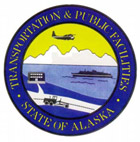Project Description and Objectives
Hydrologic information is needed for evaluation, design, and management of public resources on the North Slope. Snowcover on the Arctic Slope of Alaska lasts up to nine months a year. Water contained in snowpack ensures that snowmelt is a major hydrological event each year. Peak discharge resulting from snowmelt is the primary runoff event for many rivers on the North Slope, particularly for the largest basins like the Colville, Sagavanirktok, and Kuparuk Rivers. Rivers flowing into the Beaufort Sea drain a large area that extends from the Brooks Range through the Northern Foothills and across the Coastal Plain before discharging into the Arctic Ocean.
This project, funded by the Alaska Department of Transportation and Public Facilities, will help characterize the major rivers and streams in watersheds in the Umiat Road Corridor. The effect of climate change may be evaluated to help determine the future impacts to resource development efforts and public infrastructure. This project is building on the many years of research the Water and Environmental Research Center has conducted in the central North Slope.
Study Area
The network of sites established for the Kuparuk Foothills and Umiat Corridor Hydrology Projects builds on the long term network of sites WERC has established in this area. Some of the existing stations have been operated for more than 20 years. The additional meteorological stations will improve the understanding of spatial changes across the watershed and allow for information to help with surface-water hydrology and transportation logistics in the area.

Map above: Umiat Study Area.
Contact
- Douglas L. Kane, Lead PI
- Water and Environmental Research Center
- University of Alaska Fairbanks
- (907) 474-7808
- dlkane@alaska.edu
- Svetlana Stuefer, Co-PI
- Water and Environmental Research Center
- University of Alaska Fairbanks
- (907) 474-2714
- sveta.stuefer@alaska.edu
- Horacio Toniolo, Co-PI
- Water and Environmental Research Center
- University of Alaska Fairbanks
- (907) 474-7977
- hatoniolo@alaska.edu
- Bill Schnabel, Co-PI
- Water and Environmental Research Center
- University of Alaska Fairbanks
- (907) 474-7789
- weschnabel@alaska.edu
- Ken Irving, Project Technical Staff
- Water and Environmental Research Center
- University of Alaska Fairbanks
- (907) 474-6152
- ken.irving@alaska.edu
- Emily Youcha, Project Technical Staff
- Water and Environmental Research Center
- University of Alaska Fairbanks
- (907) 474-2713
- ekyoucha@alaska.edu



